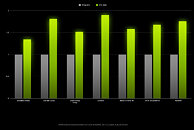Raevenlord
News Editor
- Joined
- Aug 12, 2016
- Messages
- 3,755 (1.21/day)
- Location
- Portugal
| System Name | The Ryzening |
|---|---|
| Processor | AMD Ryzen 9 5900X |
| Motherboard | MSI X570 MAG TOMAHAWK |
| Cooling | Lian Li Galahad 360mm AIO |
| Memory | 32 GB G.Skill Trident Z F4-3733 (4x 8 GB) |
| Video Card(s) | Gigabyte RTX 3070 Ti |
| Storage | Boot: Transcend MTE220S 2TB, Kintson A2000 1TB, Seagate Firewolf Pro 14 TB |
| Display(s) | Acer Nitro VG270UP (1440p 144 Hz IPS) |
| Case | Lian Li O11DX Dynamic White |
| Audio Device(s) | iFi Audio Zen DAC |
| Power Supply | Seasonic Focus+ 750 W |
| Mouse | Cooler Master Masterkeys Lite L |
| Keyboard | Cooler Master Masterkeys Lite L |
| Software | Windows 10 x64 |
NVIDIA themselves have shared performance slides for their imminent RTX 3090 graphics card, the new halo product that's been marketed as the new Titan. Previous-gen Titans have achieved extremely meager performance uplifts compared to NVIDIA's top-of-the-line cards (see RTX 2080 Ti vs RTX Titan, an average of 8% performance difference in favor of the Titan. According to the company, users should expect a slightly higher performance uplift this time around, though the 10-15% higher performance in 4K still seems meager - in pure price/performance terms - for the average consumer.
The average consumer who isn't the main focus for this graphics card and its gargantuan 24 GB of GDDR6X memory, anyway - this is more aimed at the semi-professional or professional crowds working with specialized software, whether it be in rendering or AI-based workloads. The RTX 3090 is thus not so much a product for the discerning computer enthusiast, but more of a halo product for gamers, and a crucial product for professionals and academics.


The meager performance difference also raises the question of an RTX 3080 Ti being launched with more silicon differences other than a doubling of memory to 20 GB. If the RTX 3090's 20% increase in on-chip resources (10,496 vs 8704 CUDA cores) offers a 10-15% performance uplift against the RTX 3080 (with an almost doubling in price, from $699 to $1,499), then that is the ceiling for the performance increase we can expect from a RTX 3080 Ti/SUPER. There isn't as much space in NVIDIA's product stack for another high-performance product as we might expect based on pricing and execution units. The one call to fame the card has is its 8K DLSS support - but it remains to be seen how relevant this becomes (this editor's bet? Not much at all). Rest assured - we'll be providing you with our usual in-depth performance reviews for NVIDIA's latest (and biggest) brainchild available in the consumer space.
View at TechPowerUp Main Site
The average consumer who isn't the main focus for this graphics card and its gargantuan 24 GB of GDDR6X memory, anyway - this is more aimed at the semi-professional or professional crowds working with specialized software, whether it be in rendering or AI-based workloads. The RTX 3090 is thus not so much a product for the discerning computer enthusiast, but more of a halo product for gamers, and a crucial product for professionals and academics.


The meager performance difference also raises the question of an RTX 3080 Ti being launched with more silicon differences other than a doubling of memory to 20 GB. If the RTX 3090's 20% increase in on-chip resources (10,496 vs 8704 CUDA cores) offers a 10-15% performance uplift against the RTX 3080 (with an almost doubling in price, from $699 to $1,499), then that is the ceiling for the performance increase we can expect from a RTX 3080 Ti/SUPER. There isn't as much space in NVIDIA's product stack for another high-performance product as we might expect based on pricing and execution units. The one call to fame the card has is its 8K DLSS support - but it remains to be seen how relevant this becomes (this editor's bet? Not much at all). Rest assured - we'll be providing you with our usual in-depth performance reviews for NVIDIA's latest (and biggest) brainchild available in the consumer space.
View at TechPowerUp Main Site









